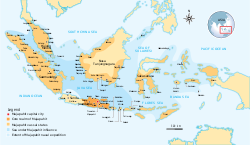| Karaton Mojopahit Kerajaan Majapahit Majapahit Empire | ||||
| ||||
 Surya Majapahit¹ | ||||
| Extent of Majapahit influence based on the Nagarakertagama; the notion of such Javanese depictions is considered conceptual. | ||||
| Capital | Majapahit, Wilwatikta (modern Trowulan) | |||
| Language(s) | Old Javanese (main), Sanskrit (religious) | |||
| Religion | Kejawen, Hinduism, Buddhism, Animism | |||
| Government | Monarchy | |||
| Raja | ||||
| - 1295-1309 | Kertarajasa Jayawardhana | |||
| - 1478-1498 | Girindrawardhana | |||
| History | ||||
| - Coronation | November 10, 1293 | |||
| - Demak invasion | 1527 | |||
| Currency | Native gold and silver coins, Kepeng (coins imported from China and later produced locally ) | |||
| Surya Majapahit (The Sun of Majapahit) is the emblem commonly found in Majapahit ruins. It served as the symbol of the Majapahit empire | ||||
| Majapahit was a vast archipelagic empire based on the island of Java from 1293 to around 1500. Majapahit reached its peak of glory during the era of Hayam Wuruk, whose reign from 1350 to 1389 marked by conquest which extended through Southeast Asia, including the present day Indonesia, Singapore, Malaysia, Brunei, southern Thailand, the Philippines, and East Timor. His achievement is also credited to his prime minister, Gajah Mada. Majapahit was one of the last major empires of the region and is considered to be one of the greatest and most powerful empires in the history of Indonesia and Southeast Asia, one that is sometimes seen as the precedent for Indonesia's modern boundaries. Its influence extended beyond the modern territory of Indonesia and has been a subject of many studies. German orientalist Berthold Laufer suggested that maja came from the Javanese name of Indonesian tree. |

0 comments:
Post a Comment